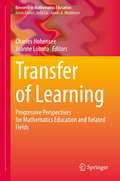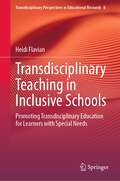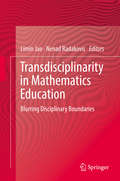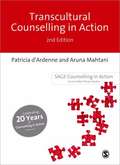- Table View
- List View
Transference and Countertransference: A Unifying Focus of Psychoanalysis
by Jean Arundale Debbie Bandler BellmanSince Freud's initial papers on transference and countertransference, these vast and inexhaustible subjects have occupied psychoanalysts. Transference and countertransference, the essence of the patient/analyst relationship, are concepts so central to pschoanalysis that, to our minds, they transcend theoretical orientation and, thus, can be seen as a unifying focus of psychoanalysis. However differently theoretical traditions conceptualize the transference, or disagree as to when and how to interpret it in our everyday analytic work, we all embrace the phenomenon as vital to psychic change.
Transference and Countertransference
by Heinrich RackerThis book presents a classic examination of transference phenomena and focuses on the development of psychoanalytic technique and theory. It addresses a perceived gap between psychoanalytic knowledge and its capacity to effect psychological transformation in a patient.
Transference and Countertransference
by Heinrich RackerThis book presents a classic examination of transference phenomena and focuses on the development of psychoanalytic technique and theory. It addresses a perceived gap between psychoanalytic knowledge and its capacity to effect psychological transformation in a patient.
Transference: The Seminar Of Jacques Lacan, Book VIII (PDF)
by Jacques Lacan Bruce Fink Jacques-Alain Miller"Alcibiades attempted to seduce Socrates, he wanted to make him, and in the most openly avowed way possible, into someone instrumental and subordinate to what? To the object of Alcibiades's desire - ágalma, the good object. I would go even further. How can we analysts fail to recognize what is involved? He says quite clearly: Socrates has the good object in his stomach. Here Socrates is nothing but the envelope in which the object of desire is found. It is in order to clearly emphasize that he is nothing but this envelope that Alcibiades tries to show that Socrates is desire's serf in his relations with Alcibiades, that Socrates is enslaved to Alcibiades by his desire. Although Alcibiades was aware that Socrates desired him, he wanted to see Socrates's desire manifest itself in a sign, in order to know that the other - the object, ágalma - was at his mercy. Now, it is precisely because he failed in this undertaking that Alcibiades disgraces himself, and makes of his confession something that is so affectively laden. The daemon of Αἰδώς (Aidós), Shame, about which I spoke to you before in this context, is what intervenes here. This is what is violated here. The most shocking secret is unveiled before everyone; the ultimate mainspring of desire, which in love relations must always be more or less dissimulated, is revealed - its aim is the fall of the Other, A, into the other, a." Jacques Lacan
Transfer of Learning: Contemporary Research and Applications
by Stephen M. Cormier Joseph D. HagmanSince the mid-1970s, scientific and educational research has left a gap in the field of basic and applied research on transfer of learning. This book fills the gap with state-of-the-art information on recent research in the field, emphasizing methodological paradigms and interpretive concepts based on contemporary cognitive/information processing approaches to the study of human behavior. Issues discussed include how transfer is measured, how its direction and magnitude are determined, how training for transfer differs from training for acquisition, and whether different principles of transfer apply to motor, cognitive, and meta-cognitive processes.
Transfer of Learning: Cognition and Instruction (ISSN #Volume .)
by Robert E. HaskellEducators and educational psychologists recognize transfer of learning as perhaps the most significant issue in all fields of instruction. Transfer of learning cuts across all educational domains, curricula, and methods. Despite its importance, research and experience clearly show that significant transfer of learning in either the classroom or in everyday life seldom occurs. Simply put, transfer of learning is illustrated by the phrases "It reminds me of..." or "It's like..." or "It's the same as...". This book addresses the fundamental problem of how past or current learning is applied and adapted to similar and/or new situations. Based on a review of the applied educational and cognitive research, as well as on the author's teaching experience with transfer of learning, this book presents a new framework for understanding and achieving transfer of learning. Current education and educational psychology textbooks either lack or lament the lack of research and guidance to educators on promoting transfer of learning. Thus this book is a necessary basis for all instruction and learning. Based on history and research, the book shows that transfer of learning is not just a technique of learning or instruction, but a way of thinking and knowing.The only nonedited educational book about transfer of learningWritten in a plain, easy-to-understand styleIllustrates how transfer of learning can be promoted in the classroom as well as in everyday lifePrescribes 11 principles for achieving transfer of learningDemonstrates how we reason using transfer of learning
Transfer of Learning: Progressive Perspectives for Mathematics Education and Related Fields (Research in Mathematics Education)
by Charles Hohensee Joanne LobatoThis book provides a common language for and makes connections between transfer research in mathematics education and transfer research in related fields. It generates renewed excitement for and increased visibility of transfer research, by showcasing and aggregating leading-edge research from the transfer research community. This book also helps to establish transfer as a sub-field of research within mathematics education and extends and refines alternate perspectives on the transfer of learning. The book provides an overview of current knowledge in the field as well as informs future transfer research.
The Transfer of Care: Psychiatric Deinstitutionalization and Its Aftermath (Routledge Library Editions: Health, Disease and Society #7)
by Phil BrownOriginally published in 1985, this book provides a comprehensive analysis of mental health policy and practice in the USA during the latter part of the 20th Century by focussing on 3 main themes: political-economic structures, the pitfalls of professionalism and institutional obstacles to adequate care.
The Transfer of Care: Psychiatric Deinstitutionalization and Its Aftermath (Routledge Library Editions: Health, Disease and Society #7)
by Phil BrownOriginally published in 1985, this book provides a comprehensive analysis of mental health policy and practice in the USA during the latter part of the 20th Century by focussing on 3 main themes: political-economic structures, the pitfalls of professionalism and institutional obstacles to adequate care.
Transfer Boy: Perspectives on Asperger Syndrome (PDF)
by Ljiljana Vuletic Michel Ferrari Teodor MihailTransfer Boy: Perspectives on Asperger Syndrome explores what it is like to be an adolescent with Asperger Syndrome, through interviews with Teodor, a 'psychologically unusual' twelve-year-old. In this detailed case study, Vuletic and Ferrari combine an autobiographical account with perspectives from other family members and people who know Teodor well, while simultaneously integrating psychiatric and psychological research on autism. The authors evaluate the merits and pitfalls of different interpretations of autism and address the broad psychological issues related to Asperger Syndrome - intelligence, social skills, memory, the transitional period from childhood to adolescence. The study includes results and interpretations of standard measures of self-concept, an IQ test and a psychiatric exam, contributing to the hitherto under-researched area of autistic self-knowledge.
Transduction Mechanisms of Drug Stimuli (Psychopharmacology Series #4)
by R. L. Balster F. C. ColpaertIn this book the latest data available on transduction mechanisms of drug stimuli are presented. A common theme underlying the chapter in this volume is the recognition that drugs can act as stimuli, in much the same manner as external events do. Accordingly, the papers focus on the mechanisms by which these stimuli are transduced at different levels of analysis, such as the behavioral, pharmacological, and molecular levels. Some chapters discuss the mechanisms of transduction of the discriminative effects of several important classes of drugs, while others deal with the methods and research strategies by which these mechanisms can be analyzed. Collectively, the papers in this volume reflect the current status of knowledge in the rapidly expanding field of behavioral pharmacology.
Transdisziplinarität in Forschung und Praxis: Chancen und Risiken partizipativer Prozesse (Schriften zur Gruppen- und Organisationsdynamik)
by Rudolf-Christian Hanschitz Esther Schmidt Guido SchwarzDer Reader richtet sich an WissenschaftlerInnen, PraktikerInnen und AuftraggeberInnen. Zahlreiche transdisziplinäre AkteurInnen brachten ihr Wissen und Können in partizipativ angelegte Prozesse ein, um dieses handlungsorientierende und handlungsanregende Handbuch für die Praxis transdisziplinären Arbeitens erstellen zu können. Es soll diesen Zielgruppen einen einführenden Zugang zu einem breit angelegten Arbeitsfeld eröffnen und Kriterien, die sich als essenziell erweisen, systematisch zur Darstellung bringen.
Transdisciplinary Teaching in Inclusive Schools: Promoting Transdisciplinary Education for Learners with Special Needs (Transdisciplinary Perspectives in Educational Research #8)
by Heidi FlavianThis book offers opportunities for better understanding teachers’ unique challenges when planning teaching sessions for learners with special needs, based on the transdisciplinary approach. The work also presents some of the core learning strategies teachers may incorporate into their teaching processes in order to promote transdisciplinary learning among learners with special needs.From a theoretical perspective, this book discusses a variety of advantages and disadvantages transdisciplinary educators may encounter, and promotes educators' development of their own vision of this area. Although the concept of special needs is often over-generalized, this book relates to the most common types of special needs among learners who study in inclusive schools: learners from different cultural background, learners with Attention Deficit Hyperactive Disability (ADHD), learners with Autism Spectrum Disorder (ASD), and learners with sensory or motor challenges. A special chapter is dedicatedto each of those groups in order to closely examine how teachers can teach those learners according to the transdisciplinary approach in practice, in inclusive classrooms. While each chapter presents different perspectives of learners with special needs, the book’s summary integrates them all and highlights the commonalities between the various needs.
Transdisciplinarity in Mathematics Education: Blurring Disciplinary Boundaries
by Limin Jao Nenad RadakovicThe book explores various facets of transdisciplinarity in mathematics education and its importance for research and practice. The book comprehensively outlines the ways that mathematics interacts with different disciplines, world views, and contexts; these topics include: mathematics and the humanities, the complex nature of mathematics education, mathematics education and social contexts, and more. It is an invaluable resource for mathematics education students, researchers, and practitioners seeking to incorporate transdisciplinarity into their own practice.
Transdiagnostic LGBTQ-Affirmative Cognitive-Behavioral Therapy: Therapist Guide (TREATMENTS THAT WORK)
by John E. Pachankis Audrey Harkness Skyler Jackson Steven A. SafrenLGBTQ individuals seek therapy at higher rates than the general population, but the mental health profession has historically lacked evidence-based guidance for supporting the unique presenting concerns of LGBTQ clients. This book changes that by presenting how-to guidance for delivering cognitive-behavioral therapy that directly responds to the distinct stressors facing LGBTQ individuals. LGBTQ-affirmative Cognitive-Behavioral Therapy is the first mental health treatment designed by and for LGBTQ individuals that has been tested in several randomized controlled trials with diverse segments of the LGBTQ community. Results of these trials show that this transdiagnostic treatment is associated with reductions in depression, anxiety, substance use problems, and psychological distress, making it suitable for a broad range of presenting concerns. LGBTQ-affirmative Cognitive-Behavioral Therapy: Therapist Guide teaches the principles and techniques that mental health practitioners can use to affirmatively respond to the distinct stressors that their LGBTQ clients often face. The book follows a clear step-by-step approach with nine modules, each of which teaches skills for enhancing LGBTQ clients' mental well-being by undoing the deep impact that early and ongoing LGBTQ-related stress can have on basic psychological processes. This Therapist Guide is intended to be accompanied by the Client Workbook, which contains accessible, step-by-step guidance and worksheets for clients to follow when participating in this treatment. This guide provides essential tools for helping therapists effectively and affirmatively respond to the unique needs of their LGBTQ clients.
Transdiagnostic LGBTQ-Affirmative Cognitive-Behavioral Therapy: Workbook (TREATMENTS THAT WORK)
by John E. Pachankis Audrey Harkness Skyler Jackson Steven A. SafrenResearch shows that LGBTQ individuals seek therapy at higher rates than the general population, and yet there is a lack of effective, evidence-based treatment support for the unique challenges facing LGBTQ individuals. This workbook changes that by presenting cognitive-behavioral therapy techniques that directly respond to the distinct stressors facing LGBTQ individuals. LGBTQ-affirmative Cognitive-Behavioral Therapy is the first mental health treatment designed by and for LGBTQ individuals to have been tested in randomized controlled trials. LGBTQ-affirmative Cognitive-Behavioral Therapy: Client Workbook is designed to enhance mental wellbeing and help you with a broad range of mental health challenges, such as depression, anxiety, substance use problems, and psychological distress. Using the exercises, quizzes, and worksheets you will learn how to monitor your feelings, thoughts, and behaviors; confront uncomfortable emotions; and learn more effective ways of coping with your experiences. It can be used individually, or in addition to the complementary Therapist Guide in a therpeautic setting. This workbook provides essential tools for helping you to effectively respond to mental health challenges in an effective, identity-affirming way.
Transdiagnostic LGBTQ-Affirmative Cognitive-Behavioral Therapy: Therapist Guide (TREATMENTS THAT WORK)
by Steven A. Safren John E. Pachankis Audrey Harkness Skyler JacksonLGBTQ individuals seek therapy at higher rates than the general population, but the mental health profession has historically lacked evidence-based guidance for supporting the unique presenting concerns of LGBTQ clients. This book changes that by presenting how-to guidance for delivering cognitive-behavioral therapy that directly responds to the distinct stressors facing LGBTQ individuals. LGBTQ-affirmative Cognitive-Behavioral Therapy is the first mental health treatment designed by and for LGBTQ individuals that has been tested in several randomized controlled trials with diverse segments of the LGBTQ community. Results of these trials show that this transdiagnostic treatment is associated with reductions in depression, anxiety, substance use problems, and psychological distress, making it suitable for a broad range of presenting concerns. LGBTQ-affirmative Cognitive-Behavioral Therapy: Therapist Guide teaches the principles and techniques that mental health practitioners can use to affirmatively respond to the distinct stressors that their LGBTQ clients often face. The book follows a clear step-by-step approach with nine modules, each of which teaches skills for enhancing LGBTQ clients' mental well-being by undoing the deep impact that early and ongoing LGBTQ-related stress can have on basic psychological processes. This Therapist Guide is intended to be accompanied by the Client Workbook, which contains accessible, step-by-step guidance and worksheets for clients to follow when participating in this treatment. This guide provides essential tools for helping therapists effectively and affirmatively respond to the unique needs of their LGBTQ clients.
Transdiagnostic LGBTQ-Affirmative Cognitive-Behavioral Therapy: Workbook (TREATMENTS THAT WORK)
by Steven A. Safren John E. Pachankis Audrey Harkness Skyler JacksonResearch shows that LGBTQ individuals seek therapy at higher rates than the general population, and yet there is a lack of effective, evidence-based treatment support for the unique challenges facing LGBTQ individuals. This workbook changes that by presenting cognitive-behavioral therapy techniques that directly respond to the distinct stressors facing LGBTQ individuals. LGBTQ-affirmative Cognitive-Behavioral Therapy is the first mental health treatment designed by and for LGBTQ individuals to have been tested in randomized controlled trials. LGBTQ-affirmative Cognitive-Behavioral Therapy: Client Workbook is designed to enhance mental wellbeing and help you with a broad range of mental health challenges, such as depression, anxiety, substance use problems, and psychological distress. Using the exercises, quizzes, and worksheets you will learn how to monitor your feelings, thoughts, and behaviors; confront uncomfortable emotions; and learn more effective ways of coping with your experiences. It can be used individually, or in addition to the complementary Therapist Guide in a therpeautic setting. This workbook provides essential tools for helping you to effectively respond to mental health challenges in an effective, identity-affirming way.
Transdiagnostic Group Therapy Training and Implementation: The Take Control Course
by Warren Mansell Rachel Bates Lydia Morris Phil Mcevoy Tanya Wallwork Jody ComiskeyTransdiagnostic Group Therapy Training and Implementation provides clinicians with a user-friendly roadmap for delivering a brief, transdiagnostic group therapy that can be used for patients suffering from stress, depression, anxiety, and a range of other related mental health problems. This is supplemented by over an hour of training videos hosted on the book’s companion website, visually demonstrating how to effectively implement the therapy. The book introduces the empirical research that has led to a greater emphasis on transdiagnostic treatment approaches, and details how to implement each phase of the therapy, supported by clinical examples to make practical application easier.Presents therapy suitable for a variety of mental health problemsOutlines how to adapt therapy for different patient populationsIncludes Method of Levels transdiagnostic cognitive therapyFeatures video demonstrations, worksheets, slides, and more on companion website
A Transdiagnostic Approach to Develop Organization, Attention and Learning Skills: The GOALS Treatment Manual for College Students
by Laura K. Hansen Brandi M. Ellis Stephanie D. SmithA Transdiagnostic Approach to Develop Organization, Attention and Learning Skills introduces the GOALS program — an innovative and skill-based approach that addresses the unique array of academic, occupational, and socio-emotional difficulties commonly faced by college students with underdeveloped executive functions. This program consists of ten sessions delivered in a group format to help college students improve their academic performance. Over the course of these sessions, participants learn strategies to prioritize tasks and assignments; schedule and manage life responsibilities; cope with life stressors; identify relevant on-campus resources; prepare for upcoming exams; take well-structured notes; maintain motivation; and several other strategies designed to reach their academic goals. Each session builds on earlier sessions, so previously learned skills lay the foundation for the successful implementation of newly learned skills. This practical and easy-to-implement program includes detailed session notes for group leaders and reproducible handouts for participants including in-session activities, session summaries, and homework assignments. This treatment manual is an essential resource for mental health providers who deliver interventions to students enrolled in post-secondary institutions pursuing undergraduate or graduate level degrees.
A Transdiagnostic Approach to Develop Organization, Attention and Learning Skills: The GOALS Treatment Manual for College Students
by Laura K. Hansen Brandi M. Ellis Stephanie D. SmithA Transdiagnostic Approach to Develop Organization, Attention and Learning Skills introduces the GOALS program — an innovative and skill-based approach that addresses the unique array of academic, occupational, and socio-emotional difficulties commonly faced by college students with underdeveloped executive functions. This program consists of ten sessions delivered in a group format to help college students improve their academic performance. Over the course of these sessions, participants learn strategies to prioritize tasks and assignments; schedule and manage life responsibilities; cope with life stressors; identify relevant on-campus resources; prepare for upcoming exams; take well-structured notes; maintain motivation; and several other strategies designed to reach their academic goals. Each session builds on earlier sessions, so previously learned skills lay the foundation for the successful implementation of newly learned skills. This practical and easy-to-implement program includes detailed session notes for group leaders and reproducible handouts for participants including in-session activities, session summaries, and homework assignments. This treatment manual is an essential resource for mental health providers who deliver interventions to students enrolled in post-secondary institutions pursuing undergraduate or graduate level degrees.
A Transdiagnostic Approach to CBT using Method of Levels Therapy: Distinctive Features (CBT Distinctive Features)
by Warren Mansell Timothy A. Carey Sara J. TaiCognitive Behavioural Therapy (CBT) is the treatment of choice for most mental health problems. Each different problem is usually treated by a different model of CBT. Yet evidence tells us that the same processes are responsible for long term distress in us all. This handy manual draws on evidence and theory to provide the key principles to aid change and recovery. The transdiagnostic approach is supported by a wealth of evidence that processes such as worry, emotion suppression, self-criticism and avoidance maintain distress across psychological disorders. Perceptual Control Theory (PCT) explains all of these processes as forms of ‘inflexible control’, and Method of Levels Therapy (MOL) helps people to let go of these habits. The principles and techniques of MOL are clearly and practically described for clinicians to offer a transdiagnostic CBT that is tailor-made to the goals of each client. This novel volume will be essential reading for novice and experienced CBT therapists, as well as counsellors and psychotherapists. Its accessible explanation of Perceptual Control Theory and its application to real world problems also makes a useful resource for undergraduates, graduates and researchers in psychology.
A Transdiagnostic Approach to CBT using Method of Levels Therapy: Distinctive Features (CBT Distinctive Features)
by Warren Mansell Timothy A. Carey Sara J. TaiCognitive Behavioural Therapy (CBT) is the treatment of choice for most mental health problems. Each different problem is usually treated by a different model of CBT. Yet evidence tells us that the same processes are responsible for long term distress in us all. This handy manual draws on evidence and theory to provide the key principles to aid change and recovery. The transdiagnostic approach is supported by a wealth of evidence that processes such as worry, emotion suppression, self-criticism and avoidance maintain distress across psychological disorders. Perceptual Control Theory (PCT) explains all of these processes as forms of ‘inflexible control’, and Method of Levels Therapy (MOL) helps people to let go of these habits. The principles and techniques of MOL are clearly and practically described for clinicians to offer a transdiagnostic CBT that is tailor-made to the goals of each client. This novel volume will be essential reading for novice and experienced CBT therapists, as well as counsellors and psychotherapists. Its accessible explanation of Perceptual Control Theory and its application to real world problems also makes a useful resource for undergraduates, graduates and researchers in psychology.
Transcultural Psychiatry (Novartis Foundation Symposia #967)
by Ruth Porter A. V. S. De ReuckThe Novartis Foundation Series is a popular collection of the proceedings from Novartis Foundation Symposia, in which groups of leading scientists from a range of topics across biology, chemistry and medicine assembled to present papers and discuss results. The Novartis Foundation, originally known as the Ciba Foundation, is well known to scientists and clinicians around the world.
Transcultural Counselling In Action (PDF)
by Patricia D'Ardenne Windy Dryden Aruna Mahtani'This is a useful introductory book, which is particularly suitable for those in training. It is well structured and easy to read and includes excerpts from therapeutic exchanges to illustrate the points made' The Journal of Critical Psychology, Counselling and Psychotherapy.



















